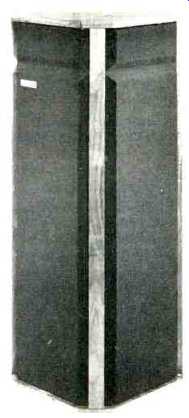
MANUFACTURER'S SPECIFICATIONS
Speaker Complement: Two 10-in. woofers, two 3 1/2-in. midrange units, and two 1-in. tweeters. Crossover Frequencies: 350 and 3,750 Hz. Impedance: 8 Ohms nominal, 7 Ohms minimum at any setting of the balance switch.
Minimum Power Required: 30 watts per channel to produce 100 dB sound pressure level in most domestic room environments.
Effective System Q: 1.0; low-frequency response -3 dB at 35.5 Hz,-6 dB at 29.5 Hz. Size: 40 in. H by 19 in. W by 10 1/4 in. front to back.
Weight: 67 lbs.
Price: $360.00 each.
For a long time it has been the contention of audio engineer Roy Allison that people listen to loudspeakers in rooms, and that recognition should be taken of the influence of the room and its boundaries in loudspeaker design and placement. He has published technical papers on this subject in the prestigious Journal of the Audio Engineering Society. But rather than be content with theoretical work, he has now made some of these ideas available in commercial products, the Allison:One and Allison:Two loudspeakers. Similar in principle of operation, the Allison:One is the big brother of the Allison:Two. The intent of these loudspeakers is to provide a uniform power response through out a room and to use the floor and wall boundaries in an optimum fashion to help achieve that goal.
The Allison:One is a floor-standing unit that uses six speakers in a three-way configuration. Dual 250-mm (10-in.) woofers are housed in a common, sealed-enclosure, acoustic-suspension design which covers the range from below 30 Hz to 350 Hz. Dual 90-mm (3 1/2-in.) mid-range units carry the acoustic load from 350 to 3750 Hz, and dual 25-mm (1-in.) tweeters cover the top end.
These speakers are housed in a vertical standing column, just over a meter tall, and are symmetrically placed on each front face of the triangular cross-sectioned enclosure. The back side of the three-sided enclosure is intended to be placed flat against a wall, which angles one of the front faces toward the normal listening area and the other away from it.
The front and top of the enclosure is oiled finish walnut veneer, with a perforated semi-rigid grille protecting the loudspeaker drivers. Well-marked terminals are housed in a protective cavity in the rear of the enclosure, which allows for flush wall placement. A three-position lever switch is provided in this cavity for adjusting the balance of the overall response between a nominally flat power curve and a slightly rolled-off slope referred to by Allison as "concert hall balance." The grilles are formed from a plastic compound that, while possessing good acoustic properties, is not terribly strong. The grilles are snapped into place in grooves in the enclosure and must be slightly deformed for removal. There is no reason for a user to remove a grille, but care should be exercised if they are, because they will crack if deformed excessively. In addition, a sharp blow, such as due to a chair shoved against the grille, could result in a damaged grille.
(Editor's Note: The makers tell us that they began using a stronger ABS type plastic for the grille about the first of the year, and that owners who have experienced difficulty with grilles of the earlier material should contact the company. -Ed.)
The Allison:One is heavy, 30 kg (67 lb.), and moderately tall, but the center of gravity is low enough that it can be tipped quite far before it could fall. However, if there are toddlers about, I would recommend that no heavy objects be placed on top of any speaker of this height for safety reasons. The Allison loudspeakers carry a full warranty for five years and this warranty is transferable.
Technical Measurements
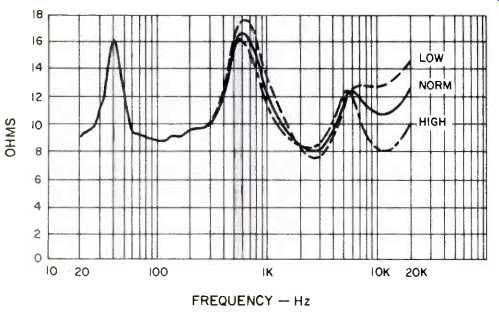
Fig. 1-Impedance versus frequency for three positions of the level control.

Fig. 2-Complex impedance
The magnitude of loudspeaker impedance for each of the three equalizer positions is plotted in Fig. 1. This shows that the Allison:One can safely be rated at 8 Ohms for the purpose of determining the load placed on the power amplifiers and the gauge of speaker wire required for an extensive run between power amplifier and speaker. The bass resonance peak has an unusual characteristic in the range from 60 Hz to 200 Hz that may be due to some interaction of the woofer with the enclosure in a standing-wave fashion.
The complex terminal impedance plot in Fig. 2 verifies this characteristic, but since the variations are small, the effect on the acoustic performance should be of little consequence. The reactive components of the impedance are quite small, which means that almost every power amplifier will be able to drive the Allison:One to the limit of that amplifier's capability without problems due to overload protection circuits coming into play.
The one-meter anechoic frequency response is plotted in Fig. 3 for two microphone positions. The curve marked "on axis" was made with the microphone directly in front of the speaker, while the other curve was made with the microphone shifted 30° in the horizontal plane. This second position is approximately along the direction for normal stereo listening. In view of the deviation of this measured performance from the sound pressure uniformity stated in brochures for this speaker, some explanation is in order.
Audio normally measures the anechoic response at a microphone position one meter from the front of the enclosure and directly in line with the geometric center of the enclosure. In the Allison:One, the dual tweeters, midrange drivers, and woofers are horizontally displaced approximately 280 mm (11 in.). The spacing between tweeters and midrange units is 130 mm (5 in.) in the vertical direction and their mean average position is 400 mm (16 in.) above the geometric axis where our measurements are performed. Thus, there is a reasonable physical spacing between drivers sharing common frequencies. Because of this, the axial response at distances of one, two, and three meters is different and possesses the absorptive dips that can be expected from measurement of widely spaced drivers. We use a microphone position one meter from the enclosure in order to remain consistent with our measurement data so that it can be compared against data from other loudspeakers.
(Editor's Note: It should be emphasized that the above mentioned anechoic frequency response measurement technique, which has been used to make this magazine's standard one-meter measurement, is not the same technique used by Allison Acoustics to make their performance warranty. Allison Acoustics considers flat power input into the room of greatest design importance, and time effects as secondary provided they are not horrible. While anechoic measurements have long been used as standard tests because of their repeatable accuracy, more recently other sorts of measurement techniques have been tried, such as Audio's three-meter room test, because, as Mr. Heyser points out, we do not listen in anechoic chambers. Two other sorts of techniques, being used by Allison Acoustics in an attempt to measure what is actually heard in a listening room, are detailed in the firm's brochure as follows: "A separate set of response curves is made for each [ midrange and high-frequency] driver so as to eliminate interference patterns which are dependent on microphone position and have little to do with true power output. Measurement conditions: Sine-wave input signal applied through system crossover network. Driver flush-mounted off center on baffle 1 meter square. B&K Model 4133 microphone 10 in. from center of driver." The brochure further notes about low-frequency response: "Low-frequency power output [ is] obtained by integrating dual-woofer response at all angles around system with enclosure at floor-wall intersection six feet from another wall. Moving system closer to other wall will increase output at low frequencies." Therefore, since all these techniques are gathering different sorts of data under rather different conditions, they should not be looked upon as tests or verification of each other or as absolutely accurate representations of what a listener will hear.)
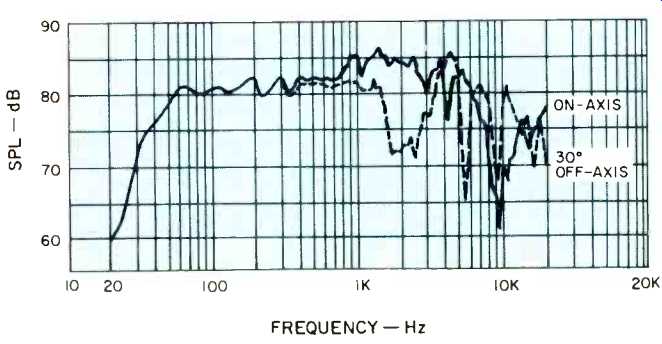
Fig. 3-One-meter anechoic sound pressure level for one watt drive.
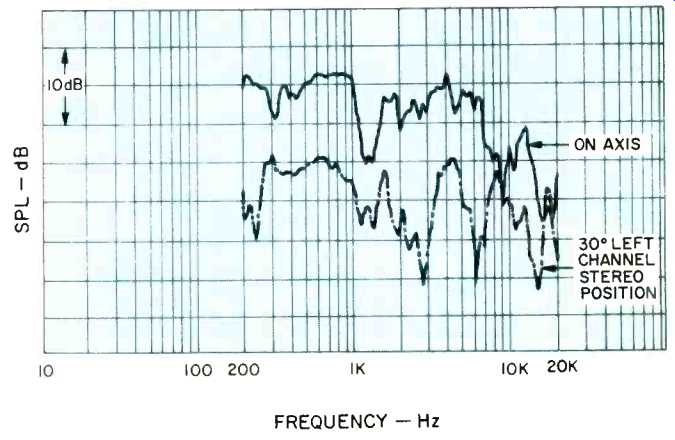
Fig. 4-Three-meter room response.
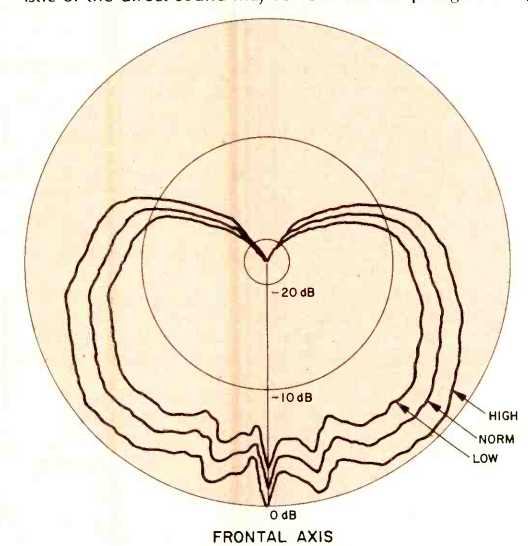
Fig. 5--Horizontal polar energy response for three equalizer positions.

Fig. 6--Harmonic distortion for the tones E1 or 41 Hz, A2 or 110 Hz, and A4
or 440 Hz.
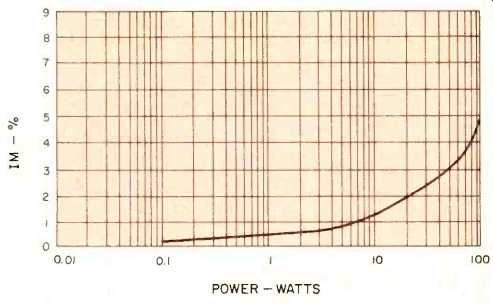
Fig. 7--Intermodulation of A4 or 440 Hz by E1 or 41.2 Hz mixed one to one.
The anechoic response was checked as a function of horizontal angle and found to have the following overall characteristic. At any single position, the response is nonuniform and possesses a number of absorptive dips. The frequency of these dips changes with azimuth and elevation angle such that, averaged over greater than 15° increments, the response is good up to beyond 22 kHz. The top end is best when the measurement is made on a direct line with the tweeters, which corresponds approximately to the position a listener would have in a normal stereo situation. Following a drop-off above 22 kHz, the response comes back up at around 38 kHz with a level only 6 dB or so below the 10 kHz to 20 kHz average response. It then falls off above 42 kHz.
Returning to the anechoic measurement, the single-microphone response is not only irregular, but strongly dependent upon the precise position of the microphone. Because of this we were unable to make a definitive phase measurement. The overall response is primarily non minimum-phase due to the interaction between drivers.
The technical interpretation of this measurement is that stereo localization is more likely to be diffuse than precise.
Because the overall energy is uniform for the total sound in a room, the balance for instrumental timbre should be reasonably good, though the non-minimum-phase characteristic of the direct sound may remove the sharp edge from percussion instruments. The low-frequency response, particularly if the enclosure is placed against the wall-floor boundary as Allison suggests, should be firm and robust.
(Editor's Note: Some caution should be exercised in interpreting phase measurements for this type of system and design philosophy, as the results are highly dependent on the precise microphone location relative to the speaker system.) Of course, we don't listen in anechoic chambers, we listen in rooms, and Fig. 4 shows the results of the measured three meter room test for the Allison:One. The frontal axis response and normal stereo listening position response are shown and are displaced 10 dB on this plot for clarity. The room response comes through a little better than the an echoic response, however, the overall characteristic still indicates the presence of diffraction effects. The spectrum from 200 Hz to 1 kHz, which is principally handled by the woofer, is moderately smooth, but diffraction effects are seen above that range, as with the anechoic measurement.
The polar energy response for the three positions of equalization is shown in Fig. 5. Horizontal dispersion is moderately uniform out to about 60° off-axis, and there is good left/right symmetry. The dispersion beyond 90 degrees is rather strong for a loudspeaker intended for flat wall emplacement, and some precaution is indicated for placing the Allison:One next to book cases or other furnishings that could allow side-launched sound to reflect into the listening position. The maker indeed recommends placement with at least 2 1/2 ft. between the cabinet center and the side wall.
Harmonic distortion is shown in Fig. 6 for the musical tones E1 or 41 Hz, A2 or 110 Hz, and A4 or 440 Hz. The distortion is particularly low for the tone A2. The distortion is quite low even at average drive levels of 100 watts. This indicates that this speaker can handle quite high sound levels without breakup and can really come alive when super power amplifiers are used.
The low distortion of the Allison:One is verified in the IM measurement of Fig. 7. The nature of this IM below 20 watts is principally due to amplitude modulation, which means that the 440-Hz tone is modulated in its level, but not its phase, by the 41 Hz tone. Above 20 watts the modulation begins to pick up phase characteristics and has a 5 degree peak-to-peak phase modulation at 100 watts.
Crescendo handling, the ability to handle momentary bursts of incoherent signals without modifying other signals at a lower average level, is also good in the Allison:One. Bursts up to 300-watts peak level can be handled without changing other tones by more than 1/2 dB.

Fig. 8--Energy-time response for axial one-meter microphone position.
Transient response is indicated by the nature of the reproduction of the loudspeaker of a perfect impulse. Figures 8 and 9 show the energy-time curve, which is one such measurement that indicates how the sound due to an impulse is spread in time. The positions chosen for Figs. 8 and 9, on axis and 30 degrees off-axis, are identical to those used in the anechoic measurement of Fig. 3. The energy-time measurements verify that most, if not all, of the frequency response irregularities are due to time delay of the sound caused by the spatial spread of multiple drivers. Impulse response measurements (not shown) indicate that the first arrival is due to a 5-kHz component, followed within 0.15 milliseconds by two combined bursts of energy around 10 kHz and 20 kHz. The majority of the sound energy arrives within one millisecond of the sound peak and within 1.5 milliseconds of the first arrival.

Fig. 9--Energy-time response for 30° off-axis one-meter microphone position.
Listening Test
The Allison:One's were placed, as recommended, standing on the floor with their back as close as possible to a wall.
In view of the specific instructions on placement, no experimentation with other speaker positions were attempted.
The first impression is that the low bass is quite good. In fact, I felt that the very low bass was, if anything, a bit heavy.
However, the sound was quite clean and the mild bass emphasis was not accompanied by any impression of muddiness or loss of clarity on percussive instruments in the bass register.
The general stereo imagery is good in lateral positioning accuracy, and there is very little subjective dependence of the position of the image with location of listening position.
In that sense, the image has the broad-stage characteristic of some systems which use wall reflections to disperse sound.
It was my opinion that the depth of the stereo image was just a bit two-dimensional and shallow.
The Allison:One can take a lot of amplifier power and deliver a clean sound at quite high levels. On the very cleanest wide-range material, the Allison:One system was able to take nearly the entire power output of a Marantz Model 500 power amplifier before showing distress, but that was at a lease-breaking power level. Those who purchase this speaker should consider a super power amplifier, if they do not have one, to make full use of the potential for handling instantaneous peak levels without audible breakup.
The reproduction of human voice was fairly accurate, in my opinion, and I felt that piano was moderately good. I preferred the reduced treble equalization position for classical music and piano. In addition, I preferred to reduce the bass slightly by preamplifier tone control for the most accurate piano reproduction.
On clean recordings of jazz and some contemporary music, I preferred the stronger high-frequency equalization position on the Allison. Brass has a good bite and some instruments came forward with the treble control up. I did not get the impression of absolute pin-point stereo imagery with the Allison:One, but neither did I sense that the reproduction was laterally smeared into Jolly Green Giant voices either.
From the standpoint of overall performance in the accurate reproduction of sound, the Allison:One is best for highly complicated, stage-filling material that can fill a room with sound.
-Richard C. Heyser
Manufacturer's Comment: There are many opinions on what a product review should be, but everybody will agree that facts should be presented clearly and accurately. I should like to point out some possible areas of ambiguity.
1. Uniform power response throughout a small room is not possible. Uniform power input to a room is possible, however, and that is the design goal of the Allison:One.
2. It is desirable to place the cabinet so that its back is close to a wall. Actual contact is not usually practical and is unnecessary; the design allows for a spacing of three inches from the rear wall without performance degradation.
3. The spectrum from 200 Hz to 1 kHz is not principally handled by the woofer section. A crossover frequency of 350 Hz is established reliably and emphatically by an LC network. By 600 Hz, the woofer output is down 14 dB and is still going down at better than 12 dB per octave.
4. It is gratifying to note that diffuse stereo localization and removal of sharp edges from percussive sounds, indicated as possible problems based on the anechoic phase measurements, were not evident in the listening tests.
-Allison Acoustics.
Editors' Note: Readers should remain assured that the technical information in these reviews is based entirely on actual laboratory measurement. Manufacturers are not allowed to participate in these measurements nor to alter the data we present. While legitimate differences of opinion may exist concerning subjective evaluation, the technical measurements are well defined and may be duplicated by any well-equipped acoustic testing facility. But these must be actual measurements, not technical inferences, to be acceptable to us.
-Richard C. Heyser & Eugene Pitts.
(Audio magazine, Apr. 1976)
Also see:
Allison Acoustics loudspeakers (ad, Oct. 1977)
Applied Physics Laboratory APL-101 Speaker System (Jun. 1974)
= = = =